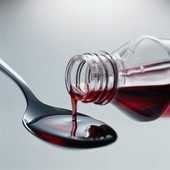
THURSDAY, May 5 (HealthDay News) — The makers of cold and fever medications that contain the painkiller acetaminophen said Wednesday night that they will discontinue infant-drops versions of the products to avoid confusion that might lead to overdoses, the Associated Press reported.
Once production ends, later this year, the companies will sell just one formula for all children under the age of 12. Companies such as Johnson & Johnson currently sell infant versions of the drugs (80 milligrams) that contain half the amount of acetaminophen found in regular children’s formulas, the news service said.
Acetaminophen is a widely used drug found in a variety of products that helps to ease pain and reduce fever. Although it’s usually safe if used according to directions, too much can damage the liver. Acetaminophen overdose is the leading cause of liver failure in the United States, with more than 50,000 people requiring emergency-room treatment each year, the AP said.
The manufacturers’ announcement preceded a U.S. Food and Drug Administration meeting scheduled for later this month, at which time agency advisers will consider whether clearer instructions and safety labeling are needed for products containing acetaminophen that are marketed for children younger than 2 years of age, the news service said.
Earlier Wednesday, the FDA issued final guidance for the production, marketing and distribution of liquid over-the-counter drug products that are measured and dispensed with provided devices such as spoons, cups and droppers.
The agency developed the guidance in response to concerns about the risk of overdoses when using liquid over-the-counter (OTC) pain relievers, cold medicines, cough syrups and digestion aids if the dispensing devices included with the products have markings that are confusing, unclear or inconsistent with the dosage directions on the label.
Among the main recommendations in the guidance:
- Dosage dispensing devices should be included with all OTC liquid drug products that are taken by mouth.
- The dispensing devices should be marked with calibrated units of liquid measurement (such as teaspoon, tablespoon, or milliliter) that match the units of measurement specified on the label directions. The devices should not have any unnecessary markings.
- Companies should ensure that dispensing devices are used only with the intended products.
- The measure markings on dispensing devices should be clearly visible when the liquid product is added to the device.
“Accidental medication overdose in young children is an increasingly common, but preventable, public health problem,” Dr. Karen Weiss, program director for the Center for Drug Evaluation and Research’s Safe Use Initiative, said in an FDA news release.
The FDA also outlined 10 tips that should be followed by parents and caregivers when giving medicine to an infant or child:
- Read and follow the Drug Facts label on OTC medicines.
- Know the active ingredient in the medicine.
- Use the dosing tool that comes with the medicine.
- Know the difference between a tablespoon and a teaspoon.
- Know your child’s weight.
- Give the right medicine, in the right amount.
- Check the medicine three times.
- Ask your doctor, pharmacist or nurse which medicines can or can’t be used at the same time.
- Always use child-resistant caps on medicines.
- Store all medicines in a safe place.
More information
The FDA has more about buying and using medicines safely.

